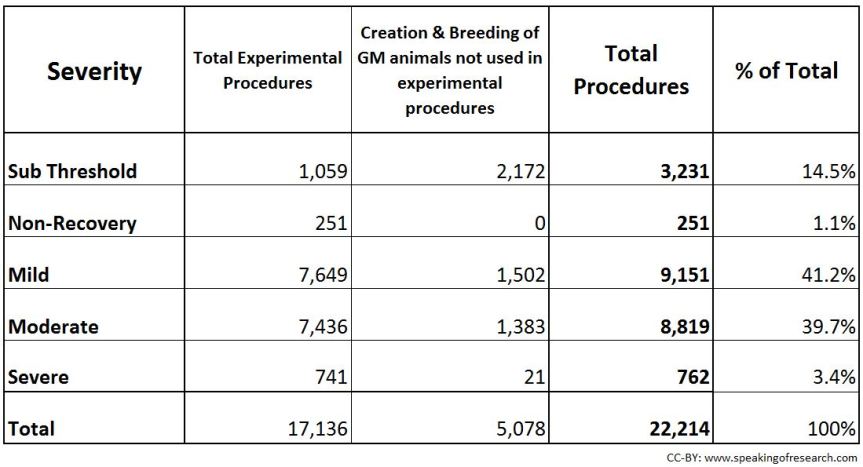Two recent events have inspired a slew of bad reporting in the UK about animal research. The first was a vote in Parliament rejecting a call to describe animals as sentient into British law. The second was the publication of the Northern Irish statistics.
On 15th November, Parliament voted down an amendment to the European Union (Withdrawal) Bill that stated “Obligations and rights contained within the EU Protocol on animal sentience set out in Article 13 of Title II of the Lisbon Treaty shall be recognised and available in domestic law on and after exit day, and shall be enforced and followed accordingly.” While there is no clear scientific definition of sentience, it has, in crude terms, been taken to mean the capacity to feel pain and/or emotion. The relevant part of the Lisbon Treaty (which Britain will withdraw from upon Brexit) reads:
In formulating and implementing the Union’s agriculture, fisheries, transport, internal market, research and technological development and space policies, the Union and the Member States shall, since animals are sentient beings, pay full regard to the welfare requirements of animals, while respecting the legislative or administrative provisions and customs of the Member States relating in particular to religious rites, cultural traditions and regional heritage.
The amendment was rejected 313 votes to 295 (roughly down party lines). A few days later a number of articles began reflecting on this. A well-shared article in The Independent by Yas Necati claimed that the Government had voted “that all animals (apart from humans, of course) have no emotions or feelings, including the ability to feel pain.”
What seems to have been ignored is that the protection of sentient animals is already embodied in British law. Most animal use is governed by the Animal Welfare Act, 2006, which protects any animals where an: “appropriate national authority is satisfied, on the basis of scientific evidence, that animals of the kind concerned are capable of experiencing pain or suffering”. The act also includes provisions to be extended to invertebrates if they seem to be able to suffer or feel pain. Essentially the Animal Welfare Act is an entire piece of UK domestic law dedicated to protecting sentient animals.
For animals in laboratories, the relevant legislation is not the Animal Welfare Act, but the Animals (Scientific Procedures) Act, 1986 (better known as ASPA). This act protects all vertebrate species, and invertebrates considered potentially able to suffer or feel pain (currently only cephalapods). The act covers all “regulated procedures” defined as those “which may have the effect of causing that animal pain, suffering, distress or lasting harm”.
Importantly, both of these acts are in domestic UK law, and so will not be affected by any future withdrawal from the European Unioin. So it seems odd that someone would claim the Government dos not believe that animals can feel pain.
It also seems odd that Necati would then claim that:
Under EU law it is illegal to test on animals for cosmetics like body wash and nail varnish. But this could easily be scrapped just like the recognition of animals as sentient beings has been.
We are looking at a very grim future for animals, where hunting is reintroduced, labs are free to test on animals with as much cruelty as they wish (and no pain relief) and farms are less and less regulated.
Necati may wish to note that the UK had already banned the use of animals to test cosmetics or their ingredients in 1998 – a full fifteen years before the EU laws came into effect. So it is unclear why this domestic ban would change upon leaving the EU. Similarly ASPA came into law in 1986 – 27 years before the EU Directive 2010/63 covering animals in research across the EU. Importantly, ASPA, 1986 was updated in 2013 to transpose aditional laws brought about by the EU Directive – this means that the EU Directive is effectively within UK law and will remain unaffected by Brexit.
The media frenzy whipped up over this issue has been such that many politicians have had to clarify the Government position, with the Prime Minister, Theresa May, also referring to it in her weekly Prime Ministers Questions:
We also recognise and respect the fact that animals are sentient beings and should be treated accordingly. The Animal Welfare Act 2006 provides protection for all animals capable of experiencing pain or suffering which are under the control of man. But I reaffirm to her that we will be ensuring that we maintain and enhance our animal welfare standards when we leave the EU.
Yas Necati was not the only one to be mistaken on this issue. Cruelty Free International (CFI) sent out a press release to Northern Irish press that combined a discussion of the annual statistical release with the parliamentary activities. As usual, there was a lot wrong with the CFI press release – not least that they managed to get the overall number of procedures in Northern Ireland wrong by mixing up the 2015 and 2016 statistics (this is literally the main number in the whole release). We decided to fully debunk the nonsense of the press release in a picture:

This is not the first time CFI have misused the severity statistics by neglecting to include experiments involving breeding and maintaining GA animals. See the table below for the full statistics (CFI only looked at the column marked “total experimental procedures” despite clearly referring to all procedures in their press release (see first blue section).
Speaking of Research will continue to call out nonsense and misinformation wherever we see it.




